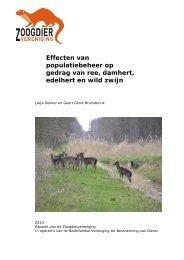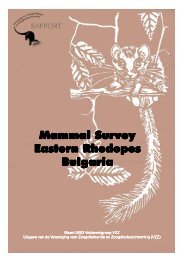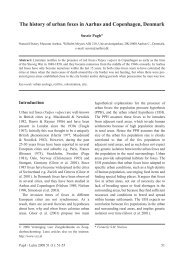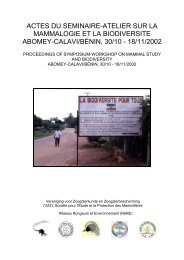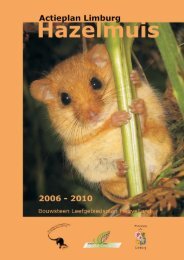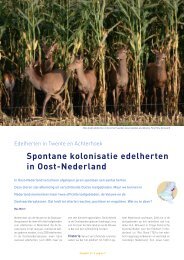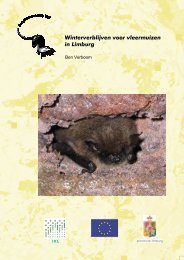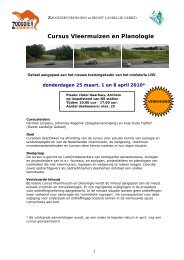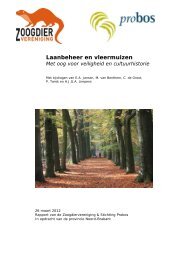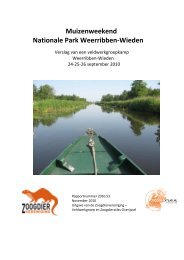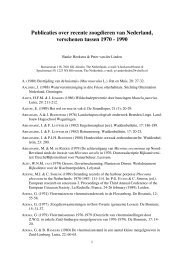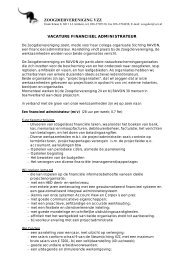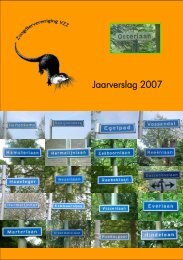Mammal survey Pol'ana - De Zoogdiervereniging
Mammal survey Pol'ana - De Zoogdiervereniging
Mammal survey Pol'ana - De Zoogdiervereniging
Create successful ePaper yourself
Turn your PDF publications into a flip-book with our unique Google optimized e-Paper software.
3.2 ROOSTS IN CHURCH LOFTS AND OTHER BUILDINGS by: Rudy van der Kuil<br />
Again this year one of the favorite activities during the day was visiting the different church-buildings in the<br />
research area. Except for church-buildings also unoccupied houses, barns, ruins and detached wooden bell<br />
towers were checked for the presence of bats. Even the attic of the townhouse of Lubietova was not safe for<br />
the researchers.<br />
3.2.1 Church buildings<br />
In the research area a total of 25 church-buildings<br />
were in fact visited (see appendix 1). The catholic<br />
churches of Cerin, Dolnas Micina and Dubravica were<br />
not visited because, according to the sexton, no bats<br />
were present there, in spite of the request of our<br />
Slovakian host Martin Celuch. A number of other<br />
churches were not suitable for bats because they were<br />
to modern, like the churches of Krivan and Korytarky.<br />
The main goal was mostly the church loft and the<br />
arched roof of the church. Here most of the<br />
observations were done. If there was a bell tower this<br />
was also included in the research.<br />
In 14 of the 25 churches that were examined bats were actually seen. In 5 instances only excrements were<br />
found, some fresh, some old, on which occasion also a dead M. myotis was found in the church of Poniky.<br />
In 5 instances no trace whatsoever was found. On the attic of the church in <strong>De</strong>tvianska Huta no animals<br />
were seen during the day (a lot of droppings though), but inflying animals were seen during the morning. The<br />
Mouse-eared bat (Myotis myotis) was the species mostly seen. It was observed in 8 cases. Apart from the<br />
1280 bats flying out of the church in Ocova, in three other churches a total of about 300 animals was<br />
counted: one group of 150, one of 75 and one of 55. In total about 2500 animals of this species were<br />
detected.<br />
In the other cases Lesser horseshoe bat (R. hipposideros), Common long-eared bat (P. auritus) and Grey<br />
long-eared bat (P. austriacus) were found. In the church of Lubietova a total of no less than 86 were counted<br />
with 1 Common long-eared bat. In the church-building of Hrochot 10 Lesser horseshoe bats were counted,<br />
together with 10 Grey long-eared bats. This species was also found in the church of Zolna (1 specimen). The<br />
Lesser horseshoe bat was also found in the churches of Dubravica (6 specimens) and Poniky Huta (8<br />
animals).<br />
3.2.2. Bell towers<br />
In the area of study a lot of solitary, mostly wooden<br />
towers are present. The purpose of these wooden<br />
towers has not become very clear. Martin Celuch<br />
mentioned that in the east of Slovakia about 1500<br />
Mouse-eared bat (M. myotis) were found in such a<br />
building, so the significance of these remarkable<br />
towers for bats was obvious.<br />
During our research 10 bell towers were visited; in<br />
three instances one single bat was found, twice a<br />
Mouse-eared bat (M. myotis) and once a Lesser<br />
horseshoe bat (R. hipposideros). In three cases only<br />
excretions were found and in four instances nothing<br />
was found.<br />
One of the visited churches.<br />
Bat droppings in a church.<br />
16 Dutch <strong>Mammal</strong> Society<br />
Photo: Jan Boshamer<br />
Photo: Rudy van der Kuil



